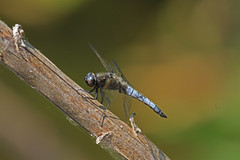After my last post, my long time blogging friend, Scott, mentioned in a comment that he was reading a book set in my part of the world, viz the fenland of East Anglia. And that reminded me that during the Covid lockdown we’ve beeen allowed to drive a few miles to exercise outdoors, and back in April I ventured over to a local fen for a walk with my camera.
The Fens are a unique ecosystem characterised by lakes, reed beds and low scrub which create habitat for a wide range of wildlife and they’re a great place to see flowers, birds, mammals and reptiles. It was a glorious sunny day when I was there and the wildlife was abundant, including this male reed bunting who posed beautifully for his portrait:
 Reed bunting (Dansk – Rørspurv, Latin – Emberiza schoeniclus)
Reed bunting (Dansk – Rørspurv, Latin – Emberiza schoeniclus)
Cuckoos (Dansk – gøg, Latin – Cuculus canorus) were cuckoo’ing all around the Fen – it’s apparently a good year for cuckoos here in the UK, and I heard one for the first time ever in the village a few weeks ago – and bittern (Dansk – rørdrum, Latin – Botaurus stellaris) were booming. The bittern is a smallish brown heron which lives and breeds in reedbeds and is extremely rare in the UK, only 191 males were recorded in the UK by the British Trust for Ornithology (BTO) in 2017. Their booming call is an amazing sound and it can carry for over a kilometre. It’s difficult to find a recording that really does it justice but if you click on the link this one hopefully gives you a good idea of what they sound like. Even though when they boom they’re very disticntive and easy to hear, they’re not easy to see unless in flight as they blend in perfectly with the background of the reedbeds. But one of these days I hope I can post one of my own pictures of a bittern to show you.
However, one bird that is easy to see is the marsh harrier:
 Marsh harrier (Dansk – Rørhøg , Latin – Circus aeruginosus)
Marsh harrier (Dansk – Rørhøg , Latin – Circus aeruginosus)
The marsh harrier is another one of the British birds of prey whose numbers have recovered significantly since the 1960’s presumably after the pesticide DDT was banned, and this one is a male hunting small mammals or birds over the low scrub of the fen.
The marsh harrier is a constant on the Fen, and it seems the bittern may be coming one too, which is fantastic. But the cuckoo isn’t, they’ve laid their eggs for the host species to rear and will soon be heading back on the perilous journey to the rainforests of sub-Saharan west Africa, hopefully to return to the UK next year to fill the spring air with their wonderfully distinctive call.




Nice to get some insight into bird life in rural England. We were some old men who walked the legendary Hadrian’s Wall a year ago. There were no bitterns there of course, but I was lucky enough to see my first in my hometown on the west coast in February last year. It was standing in the snow along a river in the middle of the city!
Thanks Hans, a late reply but got there in the end. That’s a great sighting, a city bittern would be a very rare thing in the UK. There are very few here but they are slowly recovering.
That bunting’s a beauty for sure!
Thanks Gary, I really liked this one because of the reeds it’s clinging to.